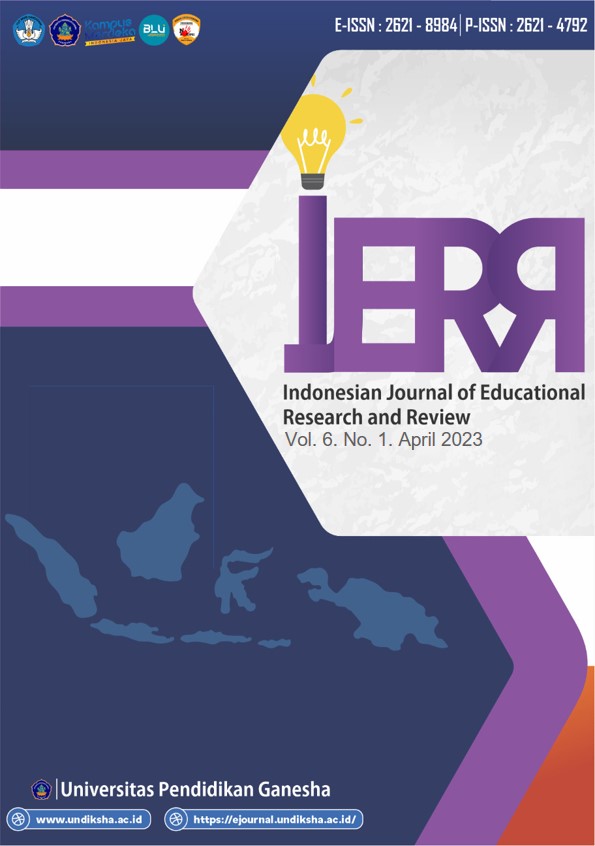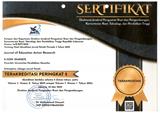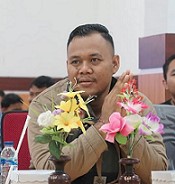Exploring an Entrepreneurial Prospective of English Language to Promote Muaro Jambi Temple
DOI:
https://doi.org/10.23887/ijerr.v6i1.53887Keywords:
English Language Prospective, Muaro Jambi Temple Tourism, Entrepreneurial Prospective, Educational Technology, Augmented RealityAbstract
Many of our cultural assets have been lost as a result of not being adequately protected. One way to prevent this situation is to carry out effective conservation at the educational level. This study aims to develop learning model to be implemented to promote a tourist destination of Candi muaro jambi as one of the cultural heritages. Research and Development with ADDIE model is used in this study. ADDIE model consist of analysis, design, development, implementation, and evaluation. This research involved the local communities where this program was implemented, five students and five English Lecturers of the English Study Program. There are three main research instruments, the fifth semester course documents of the English Study Program, field survey and interview. Data were analysed using qualitative techniques. The result reveals three prospective schemes of English language needed by local people to endorse Candi Muaro. They are daily talk of English language training for local communities, technological utilization for tourist publication and promotion, and English tour guiding Instruction. It is expected these outcomes can accelerate the development of Candi Muaro Jambi to be well-promoted and it is further recommended to explore more about other outlooks of Candi Muaro Jambi to be famous to all over the countries around the world.
References
Amaliya, C., Setiawan, W., & Novianti, E. (2012). Hubungan Penggunaan website muara jambi pilgrimage dengan pemenuhan kebutuhan informasi pengumjung situs tentang candi muaro jambi. E-Jurnal Mahasiswa Universitas Padjadjaran, 1(1), 1–13. https://www.academia.edu/download/54604620/1209-2331-1-PB.pdf.
Anggraeni, H., Fauziyah, Y., & Fahyuni, E. F. (2019). Penguatan Blended Learning Berbasis Literasi Digital Dalam Menghadapi Era Revolusi Industri 4.0. Al-Idarah : Jurnal Kependidikan Islam, 9(2), 190–203. https://doi.org/10.24042/alidarah.v9i2.5168.
Anra, Y., & Syarifuddin, A. (2019). Pelestarian Situs Kepurbakalaan Candi Muara Jambi di Kecamatan Muaro Sebo Kabupaten Muaro Jambi. Jurnal Ilmiah Dikdaya, 9(1), 141–144. https://doi.org/10.33087/dikdaya.v9i1.134.
Barbieri, L., Bruno, F., & Muzzupappa, M. (2017). Virtual museum system evaluation through user studies. Journal of Cultural Heritage, 26, 101–108. https://doi.org/10.1016/j.culher.2017.02.005.
Chassagne, P., Bou-Saïd, E., Ceccotti, A., Jullien, J. F., & Togni, M. (2007). The contribution of numerical simulation for the diagnosis of the conservation of art objects. Journal of Cultural Heritage, 8(3), 215–222. https://doi.org/10.1016/j.culher.2007.04.001.
Erida, E., Yuniarti, Y., & Fatricia, R. S. (2018). Delivery Strategy and Marketing Communication of Tourism Services (Tourism Destination Study Muaro Jambi Temple). Journal of Business Studies and Management Review, 1(2), 72–78. https://doi.org/10.22437/jbsmr.v1i2.5355.
Firsty, O., & Suryasih, I. A. (2019). Strategi pengembangan candi muaro jambi sebagai wisata religi. Jurnal Destinasi Pariwisata, 7(1), 36. https://ojs.unud.ac.id/index.php/destinasipar/article/download/53217/31485.
Gunawan, F. (2014). The Prophetic Spirit In Lontara Pananrang Script At Islamic Bugis Society. In Paper Disampaikan Pada International Conference of Islamic Civilization, 29–31. https://www.researchgate.net/profile/fahmi-alimin/publication/325594447_the_prophetic_spirit_in_lontara_pananrang_script_at_islamic_bugis_society_1/links/5b1783ca0f7e9b1912b3a0c0/the-prophetic-spirit-in-lontara-pananrang-script-at-islamic-bugis-society-1.
Islamoglu, Ö. (2018). The importance of cultural heritage education in early ages. Int. J. Educ. Sci, 22, 19–25. https://www.researchgate.net/profile/Oezge-Sever-Islamoglu/publication/328966230_The_Importance_of_Cultural_Heritage_Education_in_Early_Ages/links/602f7fcc92851c4ed58068ba/The-Importance-of-Cultural-Heritage-Education-in-Early-Ages.pdf.
Lasso, A., & Dahles, H. (2018). Are tourism livelihoods sustainable? Tourism development and economic transformation on Komodo Island, Indonesia. Asia Pacific Journal of Tourism Research, 23(5), 473–485. https://doi.org/10.1080/10941665.2018.1467939.
Linggih, I. N., & Sudarsana, I. K. (2020). The dynamics of rejang renteng dance in bali as an intangible cultural heritage of the world. Space and Culture, India, 7(4), 45–58. https://doi.org/10.20896/saci.v7i4.580.
Mansyur, S. (2016). Studi Konseptual Museum Negeri Sirisori Islam. Kapata Arkeologi, 9(2), 89. https://doi.org/10.24832/kapata.v9i2.207.
Meyer, É., Grussenmeyer, P., Perrin, J. P., Durand, A., & Drap, P. A. (2007). Web information system for the management and the dissemination of Cultural Heritage data. Journal of Cultural Heritage, 8(4), 396–411. https://doi.org/10.1016/j.culher.2007.07.003.
Nadhiroh, U. (2021). Peranan Pembelajaran Bahasa Jawa Dalam Melestarikan Budaya Jawa. JISABDA: Jurnal Ilmiah Sastra Dan Bahasa Daerah, Serta Pengajarannya, 3(1), 1–10. https://doi.org/10.26877/jisabda.v3i1.9223.
Ott, M., & Pozzi, F. (2008). ICT and cultural heritage education: Which added value? In Emerging Technologies and Information Systems for the Knowledge Society: First World Summit on the Knowledge Society, 131–138. https://link.springer.com/chapter/10.1007/978-3-540-87781-3_15.
Pajriah, S. (2018). Peran Sumber Daya Manusia Dalam Pengembangan Pariwisata Budaya Di Kabupaten Ciamis. Jurnal Artefak, 5(1), 25. https://doi.org/10.25157/ja.v5i1.1913.
Politou, E. A., Pavlidis, G. P., & Chamzas, C. (2004). JPEG2000 and the dissemination of cultural heritage databases over the Internet. IEEE Transactions on Image Processing, 13(3), 293– 301. https://doi.org/10.1016/j.heliyon.2021.e06971.
Ruhanen, L. (2013). Local government: facilitator or inhibitor of sustainable tourism development? Journal of Sustainable Tourism, 1(1), 80–98. https://doi.org/10.1080/09669582.2012.680463.
Saufi, A., O’Brien, D., & Wilkins, H. (2014). Inhibitors to host community participation in sustainable tourism development in developing countries. Journal of Sustainable Tourism, 22(5), 801–820. https://doi.org/10.1080/09669582.2013.861468.
Sinuhaji, T. U., & Lubis, S. (2019). The Participation of Community in Tourism Development of the Muara Jambi Temple Complex, Muaro Jambi Regency. ,. Britain International of Humanities and Social Sciences (BIoHS) Journal, 1(2), 62–71. https://doi.org/10.33258/biohs.v1i2.36.
Sofyan, H., Anggereini, E., Muazzomi, N., & Larasati, N. (2020). Developing an electronic module of local wisdom based on the area learning model at Kindergarten Jambi city. International Journal of Innovation, Creativity and Change, 11(2), 216–231. https://www.ijicc.net/images/vol11iss2/11215_Sofyan_2020_E_R.pdf.
Styliani, S., Fotis, L., Kostas, K., & Petros, P. (2009). Virtual museums, a survey and some issues for consideration. Journal of Cultural Heritage, 10(4), 520–528. https://doi.org/10.1016/j.culher.2009.03.003.
Sukmana, E., Brahmantyo, H., & Mumin, A. T. (2018). The Influence of Community Participation, The Role of Village Government, Number of Tourist Visits, and Village Income on Community Welfare in Cibuntu and Citundun Tourism Villages. ,. TRJ Tourism Research Journal, 2(2), 61–77. https://doi.org/10.30647/trj.v2i2.37.
Syaputra, M. A. D., Sariyatun, S., & Ardianto, D. T. (2020). Pemanfaatan situs purbakala candi muaro jambi sebagai objek pembelajaran sejarah lokal di era digital. Jurnal Pendidikan Sejarah Indonesia, 3(1), 77-87. https://core.ac.uk/download/pdf/328160812.pdf.
Sylvia, R. (2017). Analisis Strategi Pengembangan Obyek Wisata Air Terjun Tumpang Dua di Kabupaten Kotabaru Kalimantan Selatan. Jurnal Ekonomi Dan Manajemen, 11(2), 253–259. https://journals.umkt.ac.id/index.php/JEM/article/view/35.
Tamin, R. P., Puri, S. R., & Hardiyanti, R. A. (2019). Exploration of Tree Species in Muaro Jambi Temple Complex. Media Konservasi, 24(3), 245–251. https://doi.org/10.29244/medkon.24.3.245-251.
Tapan, M. (2014). Our Problems of Conservation Architecture and Urbanization. Republic Books.
Tzima, S., Styliaras, G., Bassounas, A., & Tzima, M. (2020). Harnessing the potential of storytelling and mobile technology in intangible cultural heritage: A case study in early childhood education in sustainability. Sustainability, 12(22), 9416. https://doi.org/10.3390/su12229416.
Van Leeuwen, T. (2015). Multimodality in education: Some directions and some questions. Tesol Quarterly, 49(3), 582–589. https://www.jstor.org/stable/43893773.
Vitasurya, V. R. (2016). Local wisdom for sustainable development of rural tourism, case on Kalibiru and Lopati village, province of Daerah Istimewa Yogyakarta. Procedia-Social and Behavioral Sciences, 216, 97–108. https://www.sciencedirect.com/science/article/pii/S1877042815061947.
Wahyuningtyas, N., Kodir, A., Idris, I., & Islam, M. (2020). Accelerating tourism development by community preparedness on disaster risk in Lombok, Indonesia. GeoJournal of Tourism and Geosites, 29(2), 545–553. https://doi.org/10.30892/gtg.29213-488.
Zamroni, Z., Dwiningrum, S. I. A., Hope, J., Kartowagiran, B., Sudartinah, T., Siteine, A., & Yao, Z. (2021). Cross-Cultural Competence in Multicultural Education in Indonesian and New Zealand High Schools. International Journal of Instruction, 14(3), 597–612. https://doi.org/10.29333/iji.2021.14335a.
Zulfanetti, Z., Heriberta, H., & Umiyati, E. (2021). MSME Socio-Economic Analysis in the Context of Development of the Muaro Jambi Temple Area. In The 3rd Green Development International Conference (GDIC 2020), 322–327. https://doi.org/10.2991/aer.k.210825.057.
Downloads
Published
How to Cite
Issue
Section
License
Copyright (c) 2023 Nyimas Triyana Safitri, Hidayati Hidayati, Dedy Kurniawan, Friscilla Wulan Tersta

This work is licensed under a Creative Commons Attribution-ShareAlike 4.0 International License.
Authors who publish with the Indonesian Journal of Educational Research and Review (IJERR) agree to the following terms:
- Authors retain copyright and grant the journal the right of first publication with the work simultaneously licensed under a Creative Commons Attribution License (CC BY-SA 4.0) that allows others to share the work with an acknowledgment of the work's authorship and initial publication in this journal.
- Authors are able to enter into separate, additional contractual arrangements for the non-exclusive distribution of the journal's published version of the work (e.g., post it to an institutional repository or publish it in a book), with an acknowledgment of its initial publication in this journal.
- Authors are permitted and encouraged to post their work online (e.g., in institutional repositories or on their website) prior to and during the submission process, as it can lead to productive exchanges, as well as earlier and greater citation of published work. (See The Effect of Open Access)












